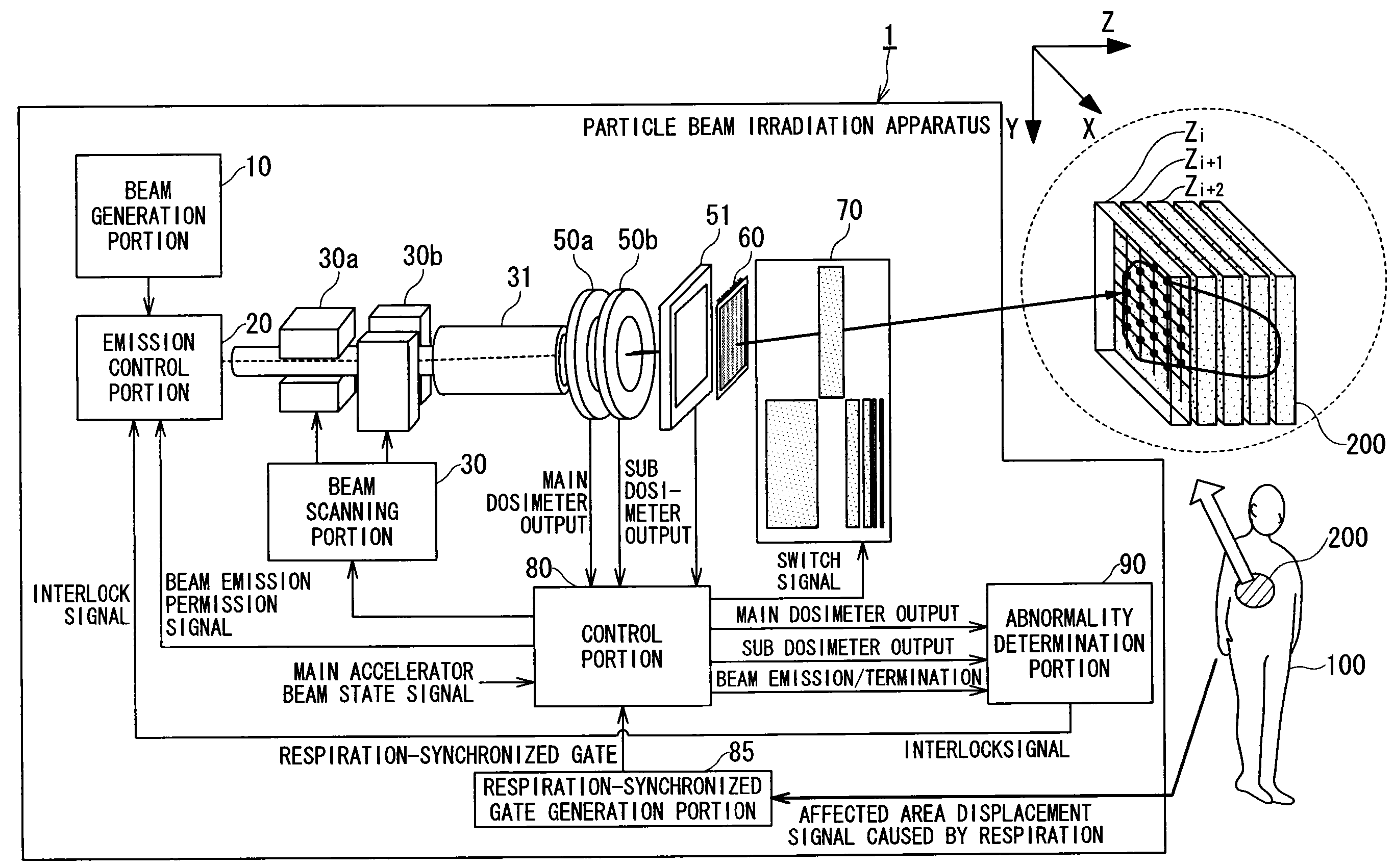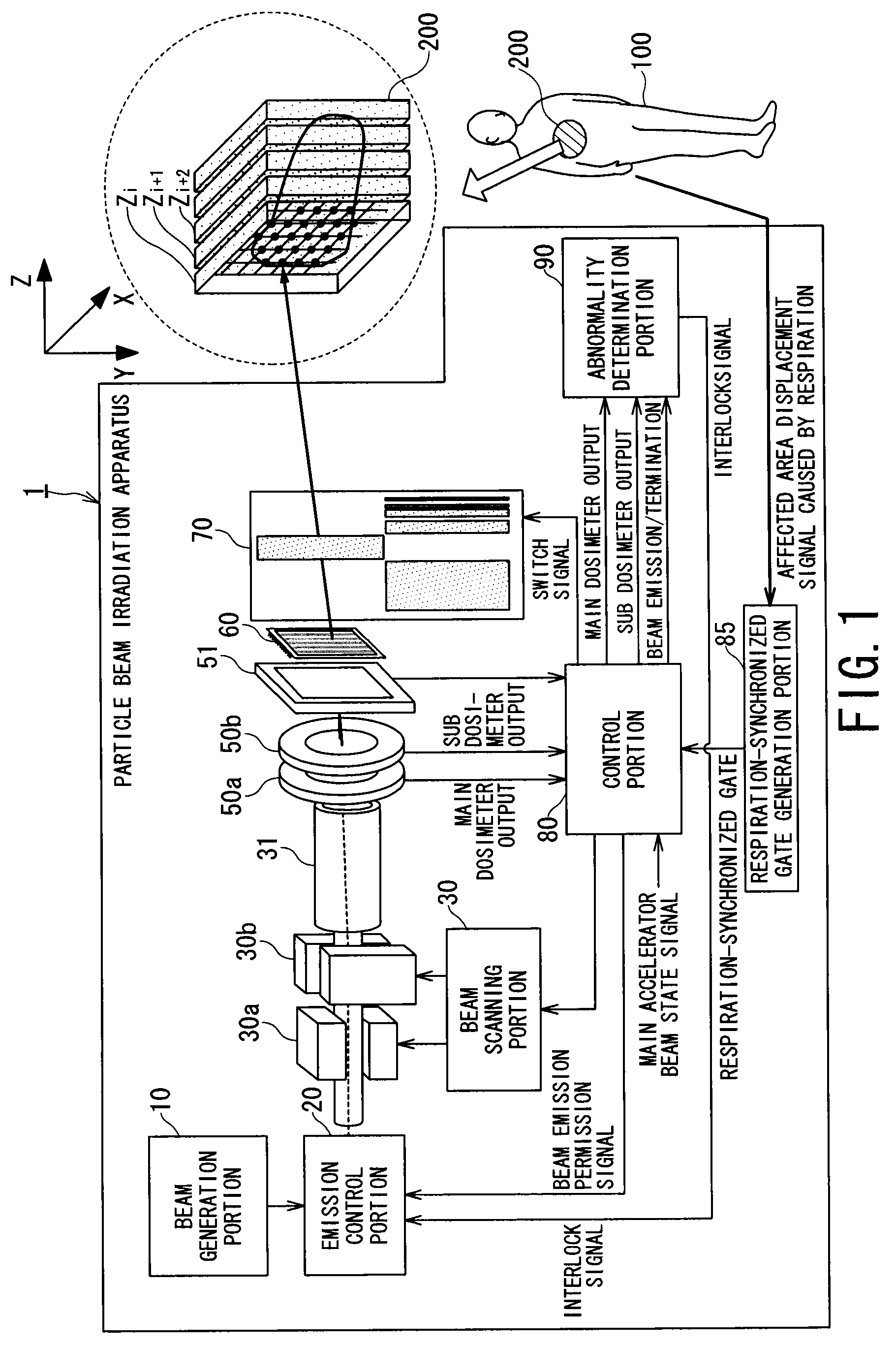Particle beam irradiation apparatus and control method of the particle beam irradiation apparatus
a particle beam irradiation and control method technology, applied in the field control method of particle beam irradiation apparatus, can solve the problems of generating radioactive waste after therapeutic irradiation, limiting the influence of normal cells around the affected area, and not being able to precisely three-dimensional adjust the beam, etc., to achieve highly sensitive measurement of leakage dose and reliable measurement of beam dos
- Summary
- Abstract
- Description
- Claims
- Application Information
AI Technical Summary
Benefits of technology
Problems solved by technology
Method used
Image
Examples
first embodiment
(3) First Embodiment
Second Abnormality Determination (Part 1)
[0086]FIG. 9 is a block diagram mainly showing an example of configuration of the abnormality determination portion 90 according to the first embodiment. The abnormality determination portion 90 according to the first embodiment includes a second main dosimeter counter 95, a second sub dosimeter counter 94, and a second abnormality determination portion 96, in addition to the configuration of the conventional abnormality determination portion 900 (FIG. 4).
[0087]Although the second main dosimeter counter 95 counts the number of pulses output from the main dosimeter 50a during the beam emission as in the main dosimeter counter 81, the integration period of the counter is smaller than that of the main dosimeter counter 81.
[0088]Although the second sub dosimeter counter 94 counts the number of pulses output from the sub dosimeter 50b during the beam emission as in the sub dosimeter counter 91, the integration period of the cou...
second embodiment
(4) Second Embodiment
Second Abnormality Determination (Part 2)
[0099]Abnormality determination according to a second embodiment is performed in parallel with the abnormality determination in the first embodiment (the first abnormality determination and the second abnormality determination (part 1)). Specifically, it is determined that there is an abnormality when an absolute value of a difference between the count value a3 of the second main dosimeter counter 95 and the count value b3 of the second sub dosimeter counter 94 exceeds a predetermined threshold. The main dosimeter 50a and the sub dosimeter 50b usually have the same configuration. Therefore, if the main dosimeter 50a and the sub dosimeter 50b are both normal, the same number of pulses would be measured. Consequently, it is determined that there is an abnormality in one of the main / sub dosimeters 50a and 50b or one of the second main / sub dosimeter counters 95 and 94 if the absolute value of the difference between the count ...
third embodiment
(5) Third Embodiment
Second Abnormality Determination (Part 3)
[0101]FIG. 13 is a diagram showing an example of configuration of an abnormality determination portion 90b according to a third embodiment. Third main / sub dosimeter counters 98 and 97 as well as a third abnormality determination portion 99 that performs leakage dose determination are added to the abnormality determination portion 90 of the first and second embodiments to form the abnormality determination portion 90b.
[0102]The third abnormality determination portion 99 compares count values a4 (third sectional dose measurement value) and b4 (fourth sectional dose measurement value) of pulses (pulses caused by leakage dose) output from the third main / sub dosimeter counters 98 and 97 during the termination of the beam emission with preset count values A4 (third reference value) and B4 (fourth reference value) for third abnormality determination defined in a pattern file 40b, respectively. If the count value exceeds the pres...
PUM
 Login to View More
Login to View More Abstract
Description
Claims
Application Information
 Login to View More
Login to View More - R&D
- Intellectual Property
- Life Sciences
- Materials
- Tech Scout
- Unparalleled Data Quality
- Higher Quality Content
- 60% Fewer Hallucinations
Browse by: Latest US Patents, China's latest patents, Technical Efficacy Thesaurus, Application Domain, Technology Topic, Popular Technical Reports.
© 2025 PatSnap. All rights reserved.Legal|Privacy policy|Modern Slavery Act Transparency Statement|Sitemap|About US| Contact US: help@patsnap.com



